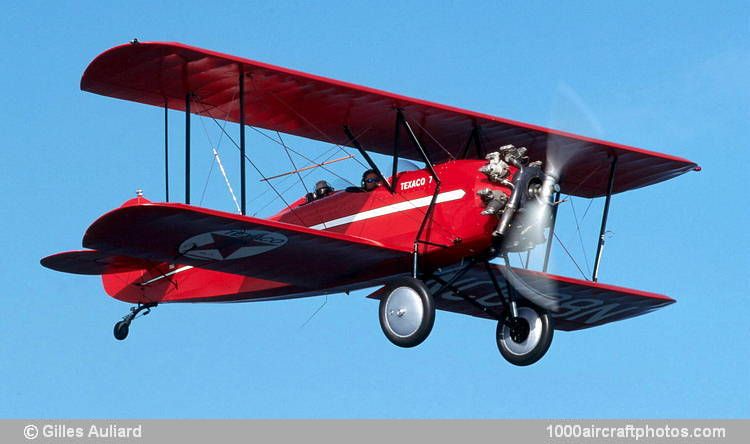01/23/2003. Remarks by Gilles Auliard: "Texaco (Texas Oil Company), has been associated with aviation almost since its beginning. The first plane to fly coast-to-coast, in 1911, used Texaco Havoline oil. The company principals understood very early the potential of commercial aviation and created in 1927 their Aviation Department to market aviation products. Within ten days the division ordered its first plane, "Texaco One", a custom built Ford Tri-Motor (NC3443) which was delivered in February, 1928. Texaco hired a daredevil pilot, Frank Hawks, to advertise the company's wings throughout the country. He embarked on the tour which he described, in his autobiography "Speed", in these terms:
"In the course of the tour, I visited 175 cities, carried 7,200 passengers, and did 56,000 mls (90,104 km) of cross-country flying. All of this without a mishap to plane and passengers".
Unfortunately, the Tri-Motor was destroyed in a crash at Floresville, Florida, on December 28, 1928. Texaco bought another fast airplane, a Lockheed Vega, better known within the company, as "Texaco Five." In February 1929, Hawks flew it fresh from the factory in Burbank, California, to New York, New York, in 18 hours 21 minutes and 59 seconds, a new USA coast-to-coast record. Four month later, Hawks and "Texaco Five" bested their own record by 43 minutes. It flew some 90,000 mls (144,810 km) before being lost in a January 1930 accident in West Palm Beach, Florida.
Hawks' next project involved crossing the US in a glider specially designed for the purpose, the Franklin PS-2, dubbed "Texaco Eaglet". This was not an easy sell, as Hawks recounted:
"There was more sales resistance to this suggestion within my own company than to anything else I had advanced, because, on the surface, it seemed foolish for a concern whose chief interest was the sale of fuel and lubricating oil to back a glider flight which required neither."
But Hawks eventually convinced the company that the glider flight would be worthwhile, and he, flying the Eaglet towed by "Texaco Seven", a Waco ASO piloted by J.D. Jernigan, began their eight day journey from San Diego, California, to New York on March 30, 1930.
The Eaglet was flown for the last time on December 8, 1930, when it landed at Bolling Field, Washington, District of Columbia, for delivery to Dr. C.G. Abbott, Secretary of the Smithsonian Institution, the new custodian of the glider. The PS-2 is awaiting transfer to its new home, the NASM's Steven F. Udvar-Hazy Center, Chantilly, Virginia, under construction as of January, 2003.
As for the Waco, its flying career is still continuing with its proud owner, Rick Hornbeck of Bowdoinheim, Maine. The aircraft was acquired by Texaco on October 11, 1929 and went on advertising the company name until 1931. Changing hands many a times over the years, it ended up in 1982 with Stuart Mitzel of Oregon City, Oregon. In 1986, the Waco was traded to Rick for two flying airplanes: a J-3 Cub and an Aeronca T and some cash.
Rick spent the next four years checking parts and examining blueprints at the NASM. He found that the airplane had been substantially modified from its original condition and that parts from other airplanes had been used in repairing the ASO. From that point, he decided that the Waco had to be completely restored, and he could not do the job himself. Looking for a good A&P mechanic with Antique experience, he found Grady Sharpe of Augusta, Maine, a retired commercial pilot and volunteer at the Owls Head Transportation Museum, in Rockland, Maine, where he was qualified on all the airplanes of the collection, including the Etrich Taube and the Henri Farman "Boxkite" replicas.
Work on the Texaco Waco started in 1990 with the disassembly of the airplane. The engine was replaced, and the adjustable metal propeller farmed out for overhaul to a shop in Phoenix. Rick spent one winter making ribs for the wing, and Grady other parts, even manufacturing the necessary tools. Finally, in 1992, the airplane started taking shape. After six years of reworking, disassembling and testing, the aircraft flew again for the first time on September 18, 1998. The few following test flights revealed a problem with the tracking in the landing gear. The gear was redesigned and certified, and new struts installed. Then on February 1, 1999, Rick flew the aircraft from Augusta to Rockland. All the systems were working perfectly, except the radios needed adjusting to try to compensate for the wind activating the microphones.
On September 24, 1999, Rick and his co-pilot/navigator Roger Poor embarked on a US tour that led them to California and back, recreating, in a more modest way, Frank Hawk's Eaglet adventure. Fifteens days later, they were back in Augusta. The Waco had performed flawlessly during the trip. Since then, the Texaco Waco hibernates in his Augusta hangar during the harsh Maine winter, and can bee seen around New England during the Fly-In season, the best chances being at the Owls Head Transportation Museum in Rockland where it is exposed most of the time."
